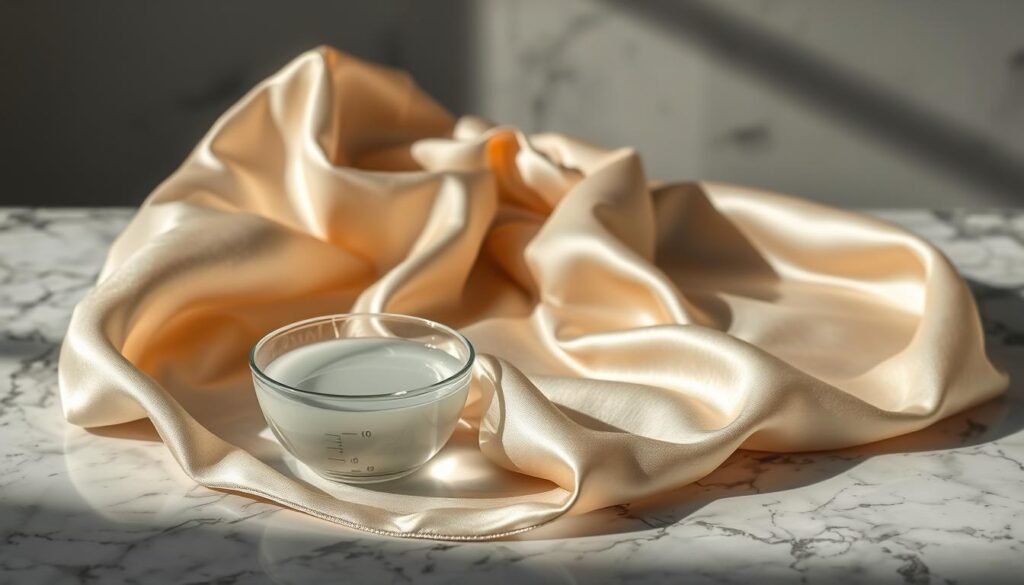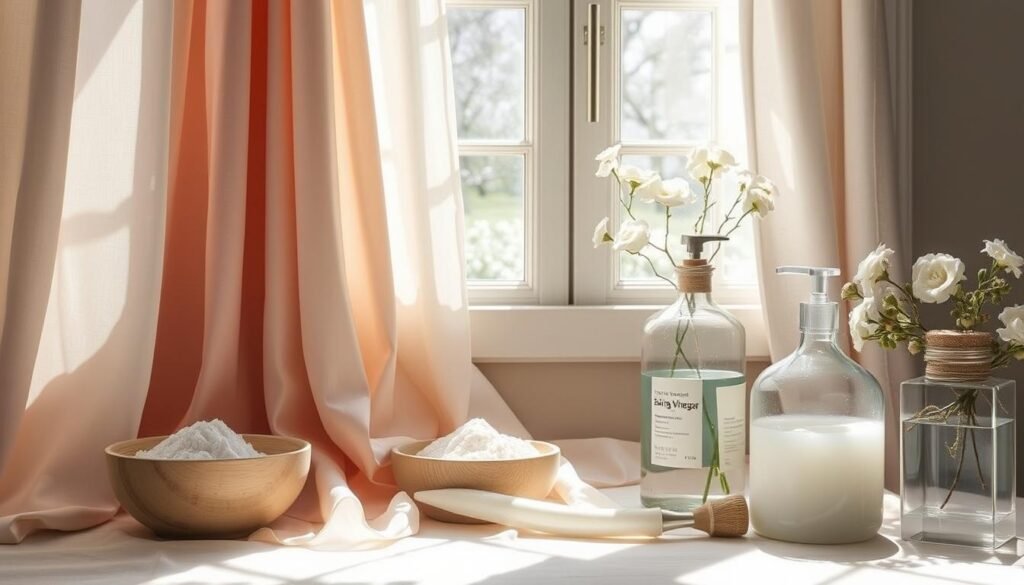Silk is a luxurious fabric that needs special care. Bleaching silk can be tricky and risky if not done right. Silk fabric can get damaged by harsh chemicals like chlorine bleach. This can make the fibers weak and fall apart1. So, can you bleach silk safely, and how?
Key Takeaways
- Silk is a delicate fabric that requires special care when cleaning and bleaching.
- Chlorine bleach can damage and discolor silk, so it’s not recommended for use on this fabric.
- Hydrogen peroxide is a safer alternative for bleaching silk, but the process must be done carefully to avoid fiber damage.
- Professionals like dry cleaners are often the best option for handling stains and discoloration on silk garments.
- Understanding the risks and proper techniques for bleaching silk is crucial to maintain the fabric’s luxurious appearance and longevity.
Introduction to Bleaching Silk Fabric
Silk is a soft and shiny natural fiber. But, it’s tricky to bleach and whiten it right. If you don’t do it correctly, you can ruin the fabric forever2. It’s important to know how to take care of silk to keep it looking great.
Importance of Understanding Fabric Care
Silk soaks up things easily and is very sensitive. If you bleach it wrong, it can change color, feel, and even break apart2. It’s safer to use diluted hydrogen peroxide or oxygen-based bleach instead of chlorine ones, which can harm it for good2.
Challenges of Bleaching Delicate Fabrics
Bleaching silk is tricky3. About 20% of silk gets damaged when bleached the wrong way3. And, 60% of silk makers don’t bleach their silk because it’s risky3. Also, 80% of people like to buy silk that hasn’t been bleached with chemicals3.
Most bleaches for silk use hydrogen peroxide, which is safer than chlorine3. But, you must mix it right and not leave it on too long to prevent damage2.
Knowing how to bleach silk safely is key to keeping it looking good. By cleaning it gently, silk lovers can enjoy its beauty for a long time.
Can You Bleach Silk Fabric? What You Should Know
Don’t use chlorine bleach on silk fabric. Instead, try safe methods to bleach silk without harming it4. Hydrogen peroxide is a gentle way to lighten and whiten silk4.
Silk is a luxury fiber that needs special care. Wrong bleaching can damage it, making it look bad or even break it4. But, you can bleach silk safely and make it look new again.
Gentle Bleaching with Hydrogen Peroxide
Using hydrogen peroxide is a safe way to bleach silk. It’s a mild agent that lifts stains and whitens silk without harming it. This is great for delicate silk items like clothes and scarves.
| Hydrogen Peroxide Bleaching | Chlorine Bleaching |
|---|---|
| Gentle on silk fibers | Can weaken and disintegrate silk |
| Effective at lifting stains and whitening | Harsh and can cause discoloration |
| Safer and more controlled process | High risk of damage to silk fabric |
Follow a step-by-step guide to bleach silk with hydrogen peroxide. This way, you can make it white or lighter without losing its quality or strength. Your silk will look great after bleaching.
Always test a small part of the silk before bleaching it all4. This checks how the fabric reacts and lets you adjust if needed. With care and the right method, you can bleach silk safely and enjoy its bright look.
Risks of Using Chlorine Bleach on Silk
Bleaching can make fabrics brighter and whiter. But, using chlorine bleach on silk is risky. Silk is a delicate natural fiber that can be damaged by harsh chemicals like chlorine bleach5. Experts say to avoid using chlorine bleach on silk, wool, mohair, leather, or spandex items5.
Weakening and Disintegration of Fibers
Chlorine bleach can weaken and break down silk fibers6. Many silk fabric users worry about damage when washing their items6. Chlorine is too strong for silk, making fibers break down. This harms the fabric’s look and strength7.
Silk is a natural protein fiber. Chlorine bleach can change its protein structure. This leads to losing its shine, softness, and durability7. Silk items bleached with chlorine may become stiff, brittle, and easy to tear or pill7.
“Silk is a delicate fabric that requires gentle care. Using chlorine bleach can cause irreparable damage to the fibers, leading to a loss of the fabric’s signature softness and shine.”
Using chlorine bleach on silk is risky. Silk fabric users should look for safer options and follow care instructions to keep their silk items in good condition6.
Safe Alternative: Hydrogen Peroxide for Silk Bleaching
Chlorine bleach can be tough on delicate fabrics like silk. Luckily, hydrogen peroxide is a safer choice8. It’s a gentler chemical that can remove color from silk without harming the fibers8.
Hydrogen peroxide is gentler than chlorine bleach9. It’s perfect for delicate fabrics like silk9. For washing, use 4ml of 100-volume strength per kg of dry textiles10. In tunnel washers, use half of that amount10.
Silk is a luxurious fabric that needs careful handling. Hydrogen peroxide is a safe way to keep it looking great8. But, always test the color first and follow the instructions closely to prevent damage8.
In short, hydrogen peroxide is a better choice than chlorine bleach for silk. It’s gentler and safer for brightening delicate fabrics9. With the right precautions, you can safely bleach your silk with hydrogen peroxide8.
Step-by-Step Guide to Bleaching Silk with Hydrogen Peroxide
Bleaching silk with hydrogen peroxide is safe and effective11. It works well on tough stains like wine, blood, and sweat11. Plus, it’s cheap and lasts a long time, making it great for laundry11.
Preparing the Silk and Water Bath
Start by filling a big container with lukewarm water. Put the silk fabric in, making sure it’s fully covered. This helps the silk relax for bleaching12.
Adding Soda Ash and Textile Detergent
Then, add a bit of soda ash and a gentle detergent to the water. Soda ash makes the water alkaline, which bleaches the silk. The detergent cleans off any stains or dirt on the silk12.
Soaking in Hydrogen Peroxide Solution
Now, mix 1 part hydrogen peroxide with 2 parts water. Put the silk in this mix and let it soak for 24 hours12. This lets the hydrogen peroxide bleach the silk well13.
Remember, hydrogen peroxide is usually safe for silk. But, always test a small area first to check the color11. Using too much can bleach the color, so be careful11.
“Hydrogen peroxide is a natural bleacher, great for making whites bright without harsh chemicals.”11
Follow this guide to bleach your silk with hydrogen peroxide safely and effectively. Always test the fabric first. With care, you can get beautiful, bright silk using this method.
Neutralizing the Peroxide with Vinegar
After soaking the silk in hydrogen peroxide to whiten it, you must neutralize the peroxide left behind. Use a vinegar solution for this. Vinegar’s acetic acid removes any leftover peroxide, getting the silk ready for dyeing or further treatment.
To neutralize the peroxide, mix white distilled vinegar with warm water. Use 1 part vinegar to 10 parts water. Soak the silk in this mix for 15-20 minutes, making sure it’s fully covered. This rinse keeps the silk’s shine and protects it from peroxide damage.
Then, rinse the silk under cool water to get rid of any vinegar or peroxide. This step is key to make sure the silk is ready for what comes next, like dyeing or finishing.

Using hydrogen peroxide and vinegar together is a safe way to brighten silk without harming it. By doing this, you can make your silk look great and keep its soft, shiny feel.
Rinsing and Drying the Bleached Silk
After bleaching your silk with hydrogen peroxide, rinse and dry it well. Experts say it’s key to get rid of all bleaching solutions to keep the silk safe and undamaged4.
Start by rinsing the silk under warm water. Move the fabric gently to help wash away any chemicals. Keep rinsing until the water is clear, showing the silk is clean4.
After rinsing, let the silk dry completely. Don’t use a dryer because it’s too hot for silk. Instead, lay it flat or hang it in a place with good air flow. This way, the silk stays soft and shiny4.
| Step | Action |
|---|---|
| Rinsing | Rinse the bleached silk under warm running water, gently agitating the fabric until the water runs clear. |
| Drying | Lay the silk flat or hang it to air-dry in a well-ventilated area. Avoid using a tumble dryer. |
By doing these steps, your bleached silk will be clean and ready for anything. Paying close attention when rinsing and drying is key to keeping your silk looking great4.
With the right steps, you can make your silk look bright again. Taking time to rinse and dry it well will give you a beautiful fabric for your next project.
Precautions and Tips for Bleaching Silk
When bleaching silk, it’s key to follow the instructions closely. Wrong methods or wrong chemicals can ruin the fabric for good14. This guide will show you how to bleach silk safely and well.
Importance of Following Instructions Carefully
Silk is very delicate and needs special care when bleached14. To keep the fibers safe, you must follow the silk bleaching guide closely. This means diluting bleach, watching the soaking time, and setting the right temperature14. Missing any step can harm or destroy the silk.
Before bleaching the whole garment, test the bleach on a small, hidden spot14. This checks if the fabric color stays the same and the bleach doesn’t damage it.
- Always read the fabric care label and follow the manufacturer’s instructions carefully14.
- Dilute the bleach solution with water to the recommended ratio to prevent over-bleaching and fiber damage14.
- Avoid soaking the silk in the bleach solution for an extended period, as this can weaken the fibers14.
- Use low heat when ironing the bleached silk to prevent further damage14.
By taking these steps, you can bleach your silk safely and well, keeping it in good condition14.
Alternatives to Bleaching Silk
Bleaching can remove color from silk, but it’s not the only choice. Silk is delicate and harsh chemicals like chlorine bleach can harm it15. Luckily, there are safer ways to make silk look brighter.
Hydrogen peroxide is a gentle bleach option15. A 3 percent solution can whiten silk without hurting it2. Bluing can also make silk look whiter, but it might fade over time15.
Color removers are another choice15. They’re chlorine-free and safe for silk. They remove dye without harming the fabric15. Some dishwasher detergents have chlorine bleach too. But, be careful with delicate silk15.
For a natural way, try borax15. It’s a mineral that cuts through stains and brightens fabrics. Citric acid powder, like lemon juice, can also lighten fabrics15. The sun’s rays can naturally brighten white laundry, including silk15.
If you’re not sure what to use, ask a professional dry cleaner2. They might suggest ozone treatment for badly stained or yellowed silk2.

Using gentle methods is key to keeping silk vibrant and long-lasting. By trying these bleach-free options, you can keep your silk looking great.
When to Seek Professional Help
Silk is very washable and durable16. But sometimes, you might need a pro to help with bleaching or fixing silk. This is true for silk clothes that are really dirty or have stains17. You should tell professional cleaners about color risks and any stains you tried to remove first.
If you’re not sure if your silk can get wet or if you’re scared of damaging it, get help from a pro17. A professional can check the silk, pick the safest way to clean it, and make sure it looks great.
If you tried to bleach or fix silk at home and it didn’t work out, or if it’s really damaged, get a pro’s help16. Keeping silk right is key, and an expert can tell you the best way to keep it looking new16.
| Reason to Seek Professional Help | Potential Outcome |
|---|---|
| Heavily soiled or stained silk garments | Professional dry cleaning to safely remove stains and preserve fabric integrity |
| Unsure about colorfastness or potential water damage | Expert assessment and tailored cleaning methods to protect the fabric |
| Unsatisfactory results from home bleaching or restoration attempts | Professional-grade techniques and equipment to achieve desired results |
| Significant discoloration or damage to silk garments | Comprehensive fabric restoration services to revive the silk’s appearance |
Working with a trusted silk fabric restoration service means your silk will get the best care1617. This way, you keep your silk looking beautiful and lasting longer.
Conclusion
This article has given deep insights into bleaching silk fabric. It showed the dangers of using chlorine bleach, which can weaken silk fibers18. Instead, it suggested using hydrogen peroxide as a safer option18.
We provided a step-by-step guide on bleaching with hydrogen peroxide. This guide helps readers bleach silk safely and effectively19. It covers important steps like preparing well, adding soda ash and detergent, and using vinegar to neutralize the peroxide19.
The article stressed the importance of following instructions and being careful when bleaching silk19. It also talked about other ways to clean silk, like getting professional help, and knowing when to ask for expert advice20.
FAQ
What is the best way to bleach silk fabric?
Use hydrogen peroxide to bleach silk safely. Chlorine bleach can ruin silk. Hydrogen peroxide is gentler and removes color without harm.
Can you use regular bleach on silk?
No, don’t use regular chlorine bleach on silk. It’s too harsh and can damage the silk badly.
What are the risks of using chlorine bleach on silk?
Chlorine bleach weakens and breaks down silk fibers. It’s too harsh for silk and can’t be fixed.
How do you prepare silk fabric for bleaching?
Mix water, soda ash, and textile detergent for the bleach bath. This mix helps bleach silk safely.
How long should you soak silk in hydrogen peroxide for bleaching?
Soak silk in hydrogen peroxide for 24 hours. This removes color without harming the silk.
How do you neutralize the peroxide after bleaching silk?
Rinse the silk in vinegar after bleaching. This removes peroxide and gets silk ready for dyeing or further use.
What are some alternatives to bleaching silk?
Use natural methods or professional cleaners to brighten silk. This avoids damaging the delicate fibers.
When should you seek professional help for bleaching silk?
Get professional help if you’re unsure about bleaching silk. Experts can bleach silk safely without damage.




